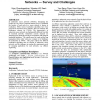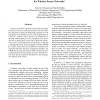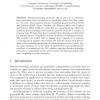209 search results - page 12 / 42 » Sensor Network Configuration Under Physical Attacks |
113
click to vote
MOBICOM
2006
ACM
15 years 5 months ago
2006
ACM
In underwater sensor networks (UWSNs), determining the location of every sensor is important and the process of estimating the location of each node in a sensor network is known a...
104
click to vote
ICDCSW
2005
IEEE
15 years 5 months ago
2005
IEEE
Internet worms have repeatedly revealed the susceptibility of network hosts to malicious intrusions. Recent studies have proposed to employ the underlying principles of worm propa...
100
click to vote
ESAS
2006
Springer
15 years 3 months ago
2006
Springer
Distance-bounding protocols aim to prevent an adversary from pretending that two parties are physically closer than they really are. We show that proposed distance-bounding protoco...
INFOCOM
2008
IEEE
15 years 6 months ago
2008
IEEE
—For sensor networks deployed to monitor and report real events, event source anonymity is an attractive and critical security property, which unfortunately is also very difficu...
GLOBECOM
2009
IEEE
15 years 3 months ago
2009
IEEE
Abstract--Wireless networks are vulnerable to identity spoofing attacks, where an attacker can forge the MAC address of his wireless device to assume the identity of another victim...



